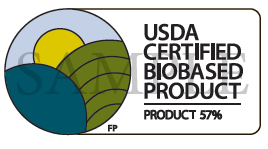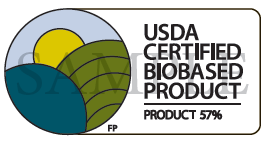 ASTM D6866 distinguishes carbon resulting from contemporary biomass-based inputs from those derived from fossil-based inputs. Biomass contains a well-characterized amount of carbon 14 that is easily differentiated from other materials such as fossil fuels that do not contain any carbon 14. Since the amount of carbon 14 in biomass is known, a percentage of carbon from renewable sources can be calculated easily from the TOTAL organic carbon in the sample. ASTM D6866 quantifies the biobased content relative to the material’s total organic content and does not consider the inorganic carbon and other non-carbon containing substances present.
ASTM D6866 distinguishes carbon resulting from contemporary biomass-based inputs from those derived from fossil-based inputs. Biomass contains a well-characterized amount of carbon 14 that is easily differentiated from other materials such as fossil fuels that do not contain any carbon 14. Since the amount of carbon 14 in biomass is known, a percentage of carbon from renewable sources can be calculated easily from the TOTAL organic carbon in the sample. ASTM D6866 quantifies the biobased content relative to the material’s total organic content and does not consider the inorganic carbon and other non-carbon containing substances present.
To illustrate, here are some hypothetical formulations and their ASTM D6866 results:
Product 1 – liquid with 50% starch-based material and 50% water Biobased Content = 100% (product 1 has 50% organic content and 100% of that fraction is biobased)
Product 2 – liquid with 50% starch-based material, 25% petroleum-based, 25% water Biobased Content = 66.7% (product 2 has 75% organic content but only 50% of that fraction is biobased)
Product 3 – solid that is 50% glass and 50% polyethylene from petroleum Biobased Content = 0% (product 3 has 50% organic carbon but from fossil sources; glass is not carbon-containing)
Product 4 – solid that is 50% glass and 50% polyethylene from biomass Biobased Content = 100% (product 4 has 50% organic carbon and 100% of it is renewable)
Product 5 – liquid with 50% soy-based material, 30% petroleum-based, 10% water, and 10% inorganic substances Biobased Content = 62.5% (product 5 has 80% organic carbon but only 50% of it is renewable)
ASTM D6866 Does Not Measure Biodegradability
It must be noted that ASTM D6866 only quantifies the biobased content of a material but results do not have any implication on the material’s biodegradability. The terms biobased and biodegradability may be related, but they are not synonymous nor are they interchangeable. If a material is biobased, it comes from plants or animals, but it does not necessarily follow that it is biodegradable. A material is biodegradable only if microbes in the environment can break it down and use it as a food source. Some forms of cellulose are, in fact, non-biodegradable while some that are derived from petroleum do biodegrade contrary to popular opinion. Nowadays there are synthetic plastic resins that will biodegrade and compost just like paper. There are also bioplastic materials, such as Braskem’s bio-polyethylene, that do not biodegrade

